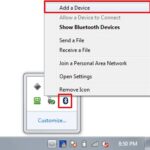The dreaded check engine light illuminates your 2008 Honda Accord’s dashboard. A quick scan reveals the OBD2 code P0400: Exhaust Gas Recirculation (EGR) Flow Malfunction. What does this mean, and what should you do? This guide provides a comprehensive overview of the P0400 code in a 2008 Honda Accord, outlining its causes, symptoms, diagnostic procedures, and potential solutions.
Understanding the P0400 Code in Your 2008 Honda Accord
The P0400 code indicates a problem with the EGR system’s ability to regulate the flow of exhaust gases back into the engine. The EGR system plays a crucial role in reducing harmful emissions and improving fuel efficiency. By recirculating a portion of the exhaust gases, combustion temperatures are lowered, minimizing the production of nitrogen oxides (NOx). A malfunction in this system can lead to increased emissions, reduced fuel economy, and potential engine performance issues.
Common Causes of P0400 in a 2008 Honda Accord
Several factors can trigger the P0400 code in your 2008 Honda Accord. The most common culprits include:
- Faulty EGR Valve: The EGR valve controls the flow of exhaust gases. A malfunctioning valve, often due to carbon buildup, can restrict or prevent proper flow.
- Clogged EGR Passages: Carbon deposits can accumulate in the EGR passages (tubes and cooler), obstructing the flow of exhaust gases.
- Vacuum Leaks: The EGR system often relies on vacuum pressure to operate. Leaks in the vacuum lines can disrupt the valve’s function.
- Faulty EGR Solenoid: The EGR solenoid controls the vacuum applied to the EGR valve. A malfunctioning solenoid can prevent proper valve operation.
- DPFE Sensor Issues: The Differential Pressure Feedback EGR (DPFE) sensor monitors the EGR flow. A faulty sensor can provide inaccurate readings, triggering the P0400 code.
Symptoms of a P0400 Code
While the illuminated check engine light is the most obvious symptom, other signs may indicate a P0400 issue:
- Rough Idle: The engine may run unevenly at idle.
- Engine Misfire: In some cases, a misfire can occur due to improper combustion.
- Reduced Fuel Economy: A malfunctioning EGR system can negatively impact fuel efficiency.
- Increased Emissions: NOx emissions may increase due to the EGR system’s inability to function correctly.
Diagnosing the P0400 Code
Diagnosing the P0400 code requires a systematic approach:
- Retrieve Codes: Use an OBD2 scanner to confirm the P0400 code and check for any other related codes.
- Visual Inspection: Inspect the EGR valve, passages, and vacuum lines for any obvious damage or blockage.
- Vacuum Testing: Check for vacuum leaks using a vacuum gauge.
- EGR Valve Testing: Test the EGR valve’s functionality using a vacuum pump or by manually activating it.
- DPFE Sensor Testing: Test the DPFE sensor’s voltage readings using a multimeter.
Fixing the P0400 Code
The solution to the P0400 code depends on the underlying cause:
- Cleaning the EGR Valve and Passages: Carbon buildup can often be removed by cleaning the EGR valve and passages with a specialized cleaner.
- Replacing the EGR Valve: If cleaning doesn’t resolve the issue, the EGR valve may need replacement.
- Repairing Vacuum Leaks: Identify and repair any vacuum leaks in the system.
- Replacing the EGR Solenoid: A faulty solenoid needs replacement.
- Replacing the DPFE Sensor: If the DPFE sensor is malfunctioning, it should be replaced.
Conclusion
Addressing the P0400 code in your 2008 Honda Accord is crucial for ensuring optimal engine performance, fuel efficiency, and emissions compliance. While some fixes can be performed by experienced DIYers, more complex issues may require professional assistance. Ignoring the P0400 code can lead to further engine problems and costly repairs down the road. Consult a qualified mechanic for accurate diagnosis and repair.

